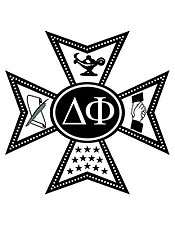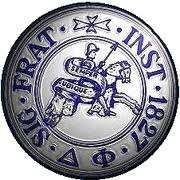Delta Phi
| The Delta Phi Fraternity | |
|---|---|
| ΔΦ | |
 | |
| Founded |
November 17, 1827 Union College |
| Type | Social |
| Scope | National |
| Motto | "Semper Ubique" |
| Colors | Columbia Blue and White |
| Symbol | The Maltese Cross |
| Patron saint | St. Elmo |
| Chapters | 13 active chapters |
| Nickname | St. Elmo Club / St. Elmo Hall |
| Headquarters |
P.O. Box 4633 Chapel Hill, North Carolina USA |
| Homepage | deltaphifraternity.org |
Delta Phi (ΔΦ) is a fraternity founded in 1827 at Union College in Schenectady, New York. Along with the Kappa Alpha Society and Sigma Phi Society, Delta Phi was the third and last member of the Union Triad.
History
Delta Phi and the other fraternities of the Union Triad were established during a time of strong anti-Masonic sentiment in the United States. Because fraternities were secret societies at the time, they also became targets of the anti-Masonic movement. This led Phi Beta Kappa, the original fraternity, to abandon secrecy and become an honor society.
In the early 1830s, Dr. Eliphalet Nott, president of Union College, called for the dissolution of all fraternities. Before this policy could be enacted, John Jay Hyde, a member of Delta Phi, argued the benefits of the fraternity system so convincingly that Nott relented and permitted the organizations to remain in existence. Hyde went on to design the badge still worn by members of Delta Phi, which includes a Maltese Cross, a symbol used by the Knights of Malta.
This connection to the Knights of Malta led Delta Phi to become known as "The St. Elmo Club", a name first used by the Omicron chapter at Yale University, which since has transformed into a senior secret society known as St. Elmo Society. The brothers there used the name of St. Elmo, the patron saint of mariners and the Knights of Malta. Some of Delta Phi's chapter houses are also known as "St. Elmo Hall".
Delta Phi today

Delta Phi remains a small fraternity with twelve active chapters and few chapters with more than several dozen members. It has resisted expansion in order to create an "intimate, personal experience"[1] for its members. The fraternity's current expansion policy is to reactivate dormant chapters.[1] As a member of the Union triad, Delta Phi is the third oldest fraternity in the United States.
Governance and organization
Owing mostly to its development in the early 19th century, Delta Phi organizes itself federally. Individual alumni chapters still exercise significant power over chapter governance. Those powers that are given in the national organization are vested in the Board of Governors.[2] The board consists of one member appointed from each alumni chapter plus two undergraduate representatives elected at the annual leadership conference the fraternity sponsors.[2] Among the duties given to the board is hiring the Executive Director who oversees day-to-day management of the fraternity.[2]
In addition to the national governing organization of the fraternity, Delta Phi alumni have also established the Saint Elmo Foundation which, among other things, sponsors the annual leadership weekend and provides scholarships to undergraduate members of Delta Phi.[3]
Alumni membership
Overall alumni participation among active chapters remains strong, with chapters hosting several social events throughout the year.[4][5]
Alumni status in Delta Phi also qualifies one to apply for membership in the Saint Elmo Club,[6] a private social club which operates at 3 West 51st Street in the Manhattan borough of New York City.[6]
On or about November 17 of every year, the national organization sponsors the Founder's Day Dinner at the Saint Elmo Club where undergraduates and alumni celebrate the founding of the fraternity.[7]
Founders
- Benjamin Burroughs, Presbyterian minister from Savannah, Georgia
- William Hun Fondey, attorney from Albany, New York
- Samuel Lewis Lamberson, Presbyterian minister from Jamaica, New York
- Samuel C. Lawrison, United States Navy surgeon from Pensacola, Florida
- David Hervey Little, New York Supreme Court Justice from Rochester, New York
- John Mason, clergyman from Jamaica, New York
- Joseph Griffiths Masten, Mayor of Buffalo from Buffalo, New York
- Thomas Clark McLaury, clergyman from Lisbon, New York
- William Wilson, President of the College of Cincinnati from Ireland
Chapters
Active chapters
There are 13 active chapters of Delta Phi.[8]
- Beta - Brown University, Providence, Rhode Island, 1830-2011[*]
- Gamma - New York University, New York, New York, 1841
- Epsilon - Rutgers University, New Brunswick, New Jersey, 1845[9]
- Eta - University of Pennsylvania, Philadelphia, Pennsylvania, 1849[10]
- Lambda - Rensselaer Polytechnic Institute, Troy, New York, 1864[11]
- Nu - Lehigh University, Bethlehem, Pennsylvania, 1884[12]
- Xi - Johns Hopkins University, Baltimore, Maryland, 1885
- Pi - Cornell University, Ithaca, New York, 1891[13]
- Rho - University of Virginia, Charlottesville, Virginia, 1908
- Phi - Kenyon College, Gambier, Ohio, 1940
- Psi - Pennsylvania State University, State College, Pennsylvania, 2015
- Chi - Hamilton College, Clinton, New York, 1950[14]
- Omega - University of Pittsburgh, Pittsburgh, Pennsylvania, 1968[15]
- Omega Alpha - College of William and Mary, Williamsburg, Virginia, 1987[16]
[*] An active fraternity that is no longer affiliated with the national organization
Inactive chapters
There are 14 inactive chapters of Delta Phi, including the Beta Chapter.[17]
- Alpha - Union College, Schenectady, New York, 1827–1999
- Delta - Columbia University, New York, New York, 1842–2001
- Zeta - Harvard University, Cambridge, Massachusetts, 1845–1901
- Theta - Princeton University, Princeton, New Jersey, 1854–1877
- Iota - University of Michigan, Ann Arbor, Michigan, 1855–1936
- Kappa - University of North Carolina, Chapel Hill, North Carolina, 1855–1861
- Mu - Colgate University, Hamilton, New York, 1874–1876
- Omicron - Yale University, New Haven, Connecticut, 1889–1925
- Sigma - Trinity College, Hartford, Connecticut, 1917–2001
- Tau - University of Illinois, Champaign, Illinois, 1920-2009
- Upsilon - Williams College, Williamstown, Massachusetts, 1926–1965
- Psi - Pennsylvania State University, State College, Pennsylvania, 1960–2007
- Omega Beta - Wabash College, Crawfordsville, Indiana, 1994–2001
Notable alumni
- John Jay Hyde - Α
- George Low - Λ - NASA administrator and 14th President of Rensselaer Polytechnic Institute
- Garret A. Hobart - E - Vice President of the United States under McKinley
- George C. Ludlow - E - Governor of New Jersey
- Paolo Montalbán - E - actor of stage and screen
- Maj. Gen. George Henry Sharpe - E - Civil War spymaster
- Howard Crosby - Γ - preacher; Chancellor of NYU
- Edgar Fawcett (1847–1904) - Δ - novelist and poet[18]
- The Harper Brothers - Δ - founders of Harper & Brothers publishing group
- John Pierpont Morgan, Jr. - Ζ - financier; founder of JP Morgan Bank and Morgan Stanley
- John Jacob Astor IV - Ζ - industrialist and philanthropist
- James Roosevelt - Ζ - General, congressman; son of Franklin D. Roosevelt
- Halsey Minor - Ρ - co-founder and former CEO of CNET Inc.
- Marvin Bush - Ρ - George W. Bush's younger brother
- Thomas B. Evans, Jr. - P - US Congressman
- Alexander Smith - T - Batman
- Stanley Forman Reed - Ρ - Associate Justice of the Supreme Court of the United States
- Charles Scribner - Θ - founder of Charles Scribner's Sons publishing group
- Russell Wayne Baker - Ξ - Pulitzer Prize–winning writer; former host of PBS show Masterpiece Theatre
- Sullivan Ballou - B - author of famous Civil War love letter at the First Battle of Bull Run
- Finn Wentworth N - businessman; COO and owner of New York Yankees; founder of YES Network; philanthropist
- George Santayana - Z - Spanish author and philosopher famous for noting that "those who cannot remember the past, are condemned to repeat it"
- George Will - Σ - Pulitzer Prize-winning conservative newspaper columnist, journalist, and author
- George Macready - B - actor
- William P. Carey - H - founder of W. P. Carey & Co.; established the Carey Business School at Johns Hopkins University, the Carey School of Law at the University of Maryland School of Law, and the W. P. Carey School of Business at Arizona State University
References
- 1 2 Delta Phi Fraternity Archived December 15, 2010, at WebCite
- 1 2 3 Delta Phi Fraternity Archived December 15, 2010, at WebCite
- ↑ http://www.st-elmo.net/foundation/ Archived February 8, 2005, at the Wayback Machine.
- ↑ Archived December 15, 2010, at WebCite
- ↑ Delta Phi at Cornell - Calendar of Events Archived December 15, 2010, at WebCite
- 1 2 Delta Phi Fraternity Archived December 15, 2010, at WebCite
- ↑ Delta Phi Fraternity Archived December 15, 2010, at WebCite
- ↑ "Active Chapters - Delta Phi Fraternity".
- ↑ Epsilon
- ↑ Eta
- ↑ Lambda
- ↑ Nu
- ↑ Pi
- ↑ Chi
- ↑ Omega
- ↑ Omega Alpha
- ↑ "Inactive Chapters - Delta Phi Fraternity".
- ↑ https://books.google.com/books?vid=OCLC38011776&id=cxATAAAAIAAJ&pg=RA1-PA29&lpg=RA1-PA29&dq=delta+hii|The#PPA21,M1
External links
- National Website
- History of Epsilon (Daily Targum, 10/2005)